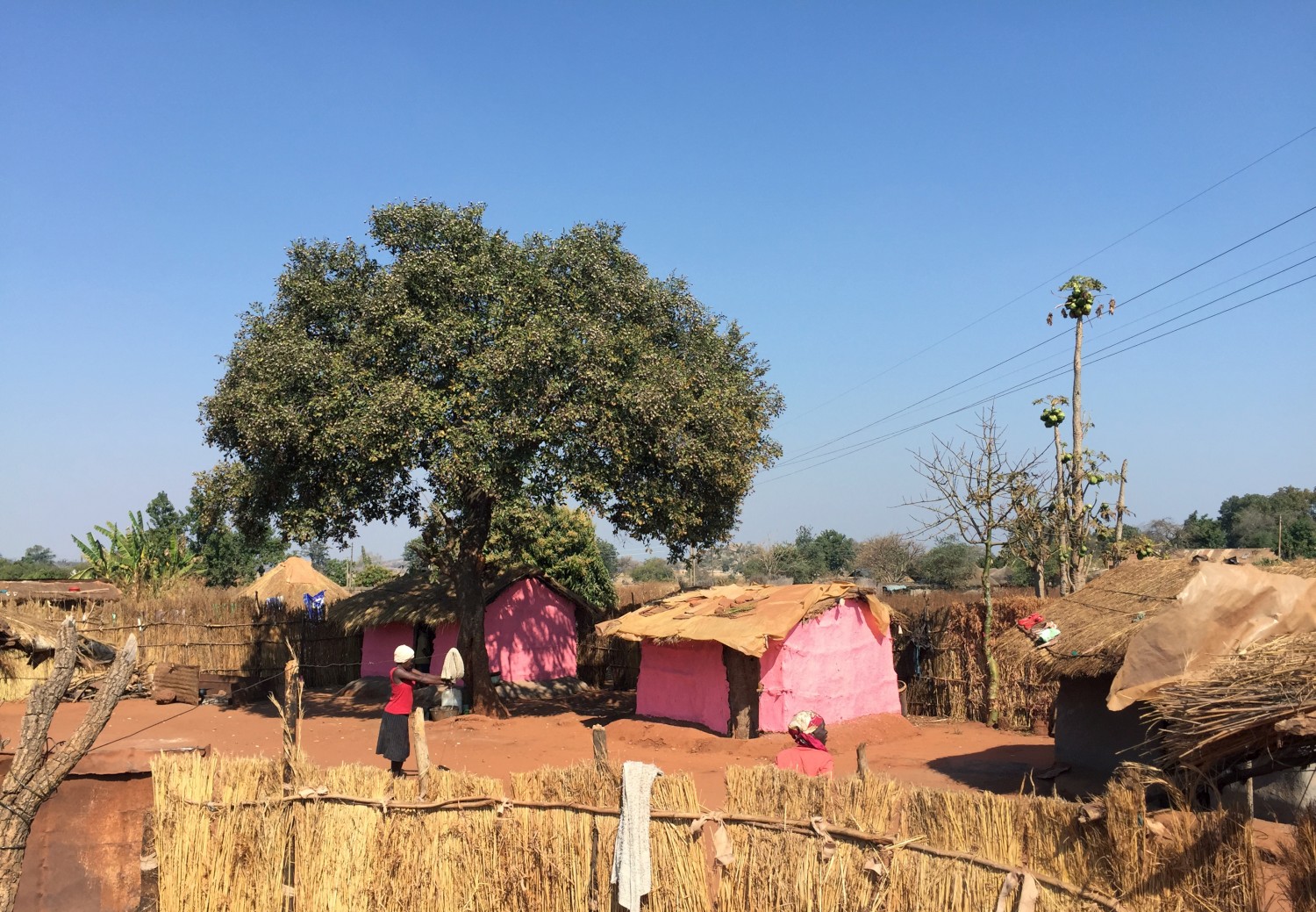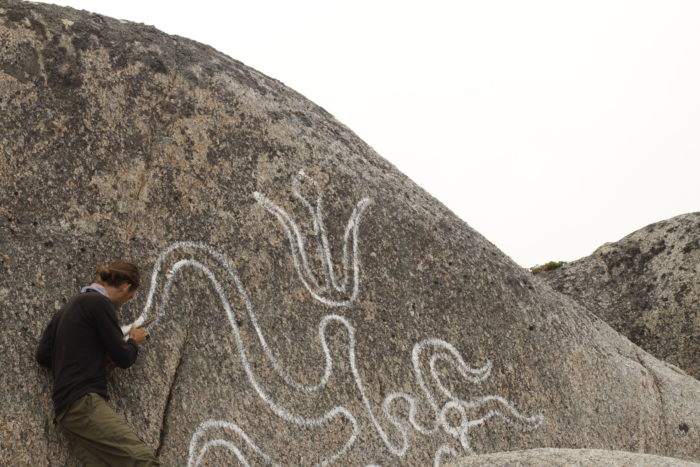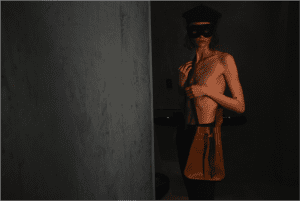Romanian-born Catinca Tabacaru has quite the resumé: originally a human rights attorney, she then switched gears and made a huge splash in the New York art world as a curator and gallery owner. Her most recent endeavor is an art collective that has taken her and several artists to some of the most remote places on the globe. We can’t wait for you to read the incredible stories she has to tell.
AZ: Tell us a bit about your professional background. What led you to start CTG Collective?
CT: I am a human rights attorney, turned curator, turned art dealer, turned co-founder of an art collective.
In 2013 I was in Romania with two artists I had worked with for years—Rachel Monosov and Justin Orvis Steimer. We were visiting my grandmother’s house in the countryside where running water only came in a few years prior. It’s where I grew up, scampering around barefoot in the woods, encountering boars and sometimes a wolf or two. The villagers of Grajdana live close to the earth, tilling the land and caring for their gardens and animals. They love me and often tell stories of my innocent childhood, sometimes remarking that I am still the same wild kid who would put daily holes in my shorts trying to climb the highest of trees.
As we became accustomed to village life and word of our presence spread over numerous valleys, the neighbors would show up at the house with gifts or offers for barter. Justin exchanged a small drawing for a 2-day old duckling that found a new mom in my grandma’s hen. Our neighbor turned up with that day’s fresh cheese, and Rachel offered to take photos of his twin girls.
We left Romania with plans to expand this experience. By not committing to one space for working—i.e. the studio or the gallery—we would let the land and culture where we found ourselves lead the way. What matters most in this moment and space? How do we engage with that while growing our circle of collaborators and creators beyond its borders? We would start by breaking the determined geographical boundaries. And so, our inaugural project, a traveling art residency we named CTG(R), was born.
AZ: Since starting CTG Collective, you’ve worked with some pretty incredible artists—what qualities did you see in them that compelled you to ask them to be a part of this project?
CT: Between Rachel, Justin and I, we tend to see a ninja when faced with one. Sometimes it’s an artist’s fascinating mind, sometimes it’s their ambition or courage or connection to the divine. Sometimes it’s raw talent and a quirky uniqueness. What brings each artist into the fold depends on their own set of qualities that makes them an important voice and an interesting human. All that said, nobody gets in who lacks kindness or empathy.
AZ: So far the collective has traveled to Zimbabwe and Newfoundland. How were these locations chosen?
CT: Sometimes I feel like the locations chose us, and not the other way around. I followed the rabbit, and that’s where it took us.
Zimbabwe showed me two artists that inspired me to look deeper. We went looking to collaborate with what seemed like a burgeoning contemporary art scene, and instead found a deep root that has brought us back over and over again, each time tying our lives closer to that land, its people, and its artists.
Newfoundland presented itself as an easy option when chasing a conversation with the wind. It turns out The Wind was only one of our conspirators on this easternmost island. The spirit of the extinct Beothuk People pulled strongly, revealing the commonalities of post-colonialism and its forever-relevant effects.
Choices of locations have been organic thus far and seem to be continuing in this way. As word is traveling about what we’ve been doing, we’ve had several institutions and groups reach out about collaborating on a residency. We’re exploring options now for 2018 and welcome all fresh ideas.

AZ: Cultural exchange is obviously an important part of what CTG Collective is doing—how has it played into the projects produced by the collective thus far?
CT: This question is right on point as we make our way to the Venice Biennale. Two years ago the three of us landed in Zimbabwe joined also by Xavier Robles de Medina and Raphael Guilbert, the Collective’s first additional members. There we met and worked closely with Admire Kamudzengerere, among other artists and curators. One year after that, we were invited back to Zimbabwe to curate our exhibition which resulted from this project, Zig Zag Zim, for the National Gallery of Zimbabwe, the country’s foremost contemporary art museum. Today, we are about to present a collaborative performance work by Admire and Rachel at the Zimbabwe Pavilion of the Venice Biennale. So our project on its face is one of cultural exchange.
Interestingly, the work itself, titled Transcultural Protocol, addresses issues of power, strength, and race while reflecting individual perception and group beliefs.
This is our third project after Zimbabwe and Newfoundland. It’s a performance so, we’re considering it being the first of a CTG(P) series.

AZ: Have there been any particular eye-opening moments regarding interactions with members of the local communities in Zimbabwe and Newfoundland?
CT: Well, we learned magic really existed. That was a strong discovery. When I was young, I used to explain my love for travel by referencing how each place offers a new lens through which to see the world. The more lenses someone has acquired, the better they can engage with different perspectives. I still believe this to be true today. The Newfies showed us a level of kindness and generosity I had not encountered before. The Zimbabweans continue to teach me as I grow spiritually and politically.

AZ: If you could collaborate on a project with any living artist, who would you choose?
CT: Alfredo Jaar.
AZ: Tell us about the most bizarre situation you’ve ever found yourself in during your travels.
CT: I was arrested and pulled into a dark little room with one light bulb hanging above a plastic table. This was 2006 in Goma, Republic of Congo, and I had not before, nor since seen so many machine guns in one town. Luckily my girlfriend who I was with was fluent in French and negotiated our way out of the situation while I distracted most of the soldiers with bikini pictures of our friends, this kept the machine guns pointed down. The combination of our two methods somehow got us out of that little darkroom.
AZ: Dream project location?
CT: Space.
AZ: Favorite art venue in the world?
CT: There are so many, each burning brighter than the next. I would encourage readers to frequent Grace Exhibition Space in Bushwick, which is a pioneer in the performance art space. If ever in Zimbabwe, Dzimbanhete Arts Interactions has raised several generations of artists and continues to offer a fascinating experience sitting somewhere between art, culture, and spirit. There are at least a dozen renowned institutions that pop into mind around the world including the Wiels in Brussels, the Beyeler Foundation in Basel, the Wanas Konst in Sweden, the Guggenheim in New York, Scrap Metal in Toronto, KOW and Plan B in Berlin, Jocelyn Wolff in Paris… I could go on. Most important is that we patronage art spaces, in whatever shape or size. Being a gallery owner myself, I know the system wouldn’t work without me, just as I couldn’t work without artists, collectors and curators. Art has intrinsic value to human evolution, and we must all be conscious of our role in it.
AZ: What’s next for CTG Collective?
CT: We’re a busy bunch.
May 2017 holds a 4-day live performance run at the Zimbabwe Pavilion of the 57th Venice Biennale: May 10-13 at 12:30 pm daily, Santa Maria Della Pieta, Venice. Then Admire Kamudzengerere’s work, and a video documenting the performance work Transcultural Protocol, developed by the Collective and authored by Admire and Rachel Monosov, will remain in the Pavilion until November.
July 2017 should see us in the South of France putting down a base for research around the concentration and propagation of positive energy from a scientific, artistic and musical perspective. Its purpose will be to balance and eventually to outweigh the negativity and injustice that currently exist on our planet. I’ll let our readers chew on that grand plan.
In August 2017 we will return to Zimbabwe to support our recently displaced community in building a new art center. We also plan to realize a new project. Let’s just say it involves the building of a large structure-cum-sculpture-cum-home.
We are also starting to think about 2018 and are exploring opportunities for collaboration with several artist groups around the world.
all images courtesy of CTG Collective // top image Rachel Monosov’s Impossible Meeting Point



